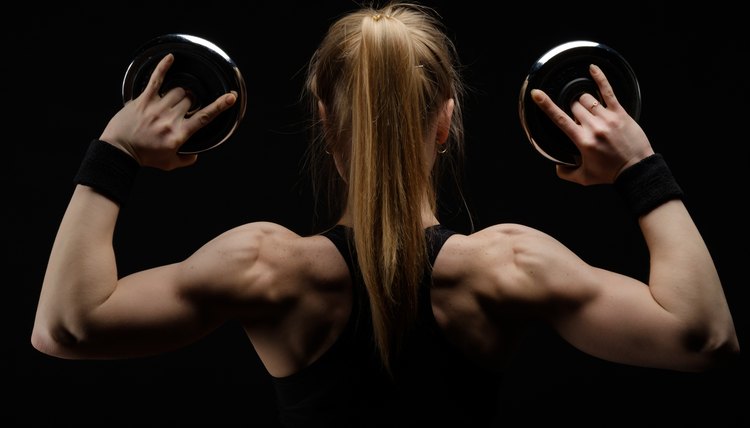What does fact checked mean?
At SportsRec, we strive to deliver objective content that is accurate and up-to-date. Our team periodically reviews articles in order to ensure content quality. The sources cited below consist of evidence from peer-reviewed journals, prominent medical organizations, academic associations, and government data.
The information contained on this site is for informational purposes only, and should not be used as a substitute for the advice of a professional health care provider. Please check with the appropriate physician regarding health questions and concerns. Although we strive to deliver accurate and up-to-date information, no guarantee to that effect is made.
Bent-Over Rear Lateral Raise or Reverse Pec Deck?

The posterior deltoids might not be first on your list of shoulder and back muscles to work, but they certainly should get some attention in your shoulder workout or back exercise routine. The posterior delts muscle group contributes to broad-looking shoulders, which is a workout goal for many. They're also important to posture; weak back shoulders can cause you to slouch, hunch and cave in at the chest. You might even experience tightness and stiffness in your neck as a result.
Two exercises commonly used to train this area are the bent-over rear lateral raise and the reverse pec deck. Both are effective isolation exercises for the rear deltoids, but appeal to different training focuses. If you find you just can't decide, consider alternating them week to week — doing the reverse pec deck for a couple of workouts, then switching to the bent-over rear lateral raise for the next few. This means you'll benefit from the subtleties of both exercises in multiple workout routines.
If you do choose the bent-over row, be sure to keep your head and neck neutral so as not to cause strain and compromise your form. Look forward at the floor just a few feet instead of checking out your muscles in the mirror.
Consider Stability
In the bent-over lateral raise, you've got a lot going on during repetitions, or reps. Your starting position is either seated or standing, hinged from your hips, grasping weight and opening and closing your arms to squeeze your shoulder muscles together. Your balance, range of motion, and body angle must be spot on to get the most for your rear delts and upper back. Your rotator cuffs will play a major role in this exercise as well.
With the reverse pec dec, you're seated in the pec deck machine backward or in the reverse pec deck machine, with your face and torso turned to the back rest. With the levers at shoulder height, place your upper arms or elbows in the lever pads and push them back, to draw the shoulder blades together. You have to focus on little else than squeezing your shoulder blades against the machine's resistance to train the rear delts. Minimal energy is wasted trying to maintain proper alignment. This is a great exercise for beginners who are not yet used to focusing on good form.
The stability of the pec deck could also be viewed as a drawback, depending on your training focus. For the people who are after more functional muscle growth, rather than singular muscle development, the balance and maintenance of the hinged position of the bent-over rear lateral raise enhances the workout's value. Your triceps, lats, rhomboids, wrist extensors, hamstrings, lower back, glutes and adductors — or inner thighs — play the important role of stabilizers. The reverse pec deck engages no notable stabilizers.
Go For Convenience
The bent-over rear lateral raise is more versatile than the reverse pec deck. Instead of being beholden to a single machine, free weights can be used to accomplish this exercise. Use dumbbells, barbells or a cable machine to do a variation of this move to target the backs of the shoulders.
That being said, you may prefer a machine that provides you with the ease of the pec deck. You simply adjust the seat and the arm levers, move the pin to the desired weight and get to exercising. No heavy weights to lug, no pulleys to move and no fear that your form is terribly off. Plus most bodybuilding gyms have this machine.
Versatility
The reverse pec deck offers one way to target the backs of your shoulders. Some machines will allow you to work one arm at a time, but it can be tricky to accomplish while seated in the machine. The bent-over rear delt fly provides you with options. Work one arm at a time while standing or sitting.
What exercises help the posterior delts?
These two exercises aren’t the only ones that work the posterior delts. For a versatile workout that also works the posterior and anterior delts, try these. Flyes are really good exercises for working the full range of motion of the back and shoulders, so add a reverse fly, chest fly, or dumbbell reverse fly to your back workout. Classic weight moving exercises like the deadlift and bench press also work the delts along with the upper body. For those who like dumbbell exercises, try bent over dumbbell row, dumbbell rear delt fly or a dumbbell incline bench.
References
Writer Bio
Andrea Cespedes is a professionally trained chef who has focused studies in nutrition. With more than 20 years of experience in the fitness industry, she coaches cycling and running and teaches Pilates and yoga. She is an American Council on Exercise-certified personal trainer, RYT-200 and has degrees from Princeton and Columbia University.
